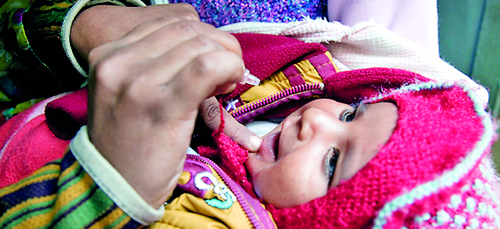Sunday Times 2
Experts split on India’s new rotavirus vaccine
[MUMBAI] Public health experts in India are divided over a government decision to introduce an indigenously developed rotavirus vaccine into the country’s universal immunisation programme (UIP) with questions being raised as to its efficacy, risks and costs.
This month (August), results for phase 3 trials of the vaccine, called Rotavac, published in Vaccine reported an efficacy of 48.90 per cent efficacy against severe rotavirus gastroenteritis in the second year of infant life. The trial’s results for the first year published in the Lancet in March reported 56.40 per cent efficacy. The study in Vaccine says ‘decisive assessment of the risk of intussusception’ has been left to phase 4 post-marketing studies. Intussusception is the telescoping of one segment of the intestine resulting in intestinal obstruction and perforation which is fatal if not treated promptly.

Image credit: Gates Foundation
Gagandeep Kang, a co-author of The Lancet and Vaccine papers, justifies introduction of a rotavirus vaccine into the government-funded UIP on the grounds that “available evidence indicates a substantial burden of rotavirus disease that could be partially alleviated by vaccination – at least 30,000 of the estimated 80,000 deaths yearly in India.”
“No drug or vaccine is completely safe,” Kang who works at the Christian Medical College, Vellore tells SciDev.Net. “The vaccine will save more lives than might be lost because of intussusception to this vaccine – a maximum of 1,350 annually in addition to the at least 9,000 that already occur from other causes.”
Data from other rotavirus vaccines indicates that more than 500,000 immunised children must be monitored to identify vaccine-related intussusception from the new vaccine, says Kang. “Instead of larger pre-licensure studies, WHO recommended post-marketing and sentinel surveillance.”
Jacob Puliyel, a paediatrician and member of the National Technical Advisory Group on Immunisation, argues that Rotavac’s reported efficacy of 56.40 per cent at one year of age and the fact that 55 infants would need to be immunised to prevent a single severe infection over a year do not economically justify its use.
Since it costs US$ 165 to vaccinate 55 infants the government would do better to treat severe infection which costs an average of US$ 50 per case, Puliyel tells SciDev.Net.
The sample size of the phase 3 trials (6,799) on which basis the vaccine was approved only evaluates efficacy and more information is needed on the risk of intussusception, a known vaccine-related complication, Puliyel says.
“India has a poor record of phase 4 trials, in addition to which pharmacovigilance is substandard,” says S. Srinivasan, managing trustee of Low Cost Standard Therapeutics, a not-for-profit based in Vadodara, Gujarat state. “So it is doubtful how much of this will really happen.”
Puliyel says the rotavirus vaccine would add US$ 81 million to the immunisation budget (US$ 105 million in 2011-2012) to cover the 27 million children born each year in India.
Rotavac, based on the 116E rotavirus strain, is developed by Bharat Biotech with financial support from the government’s department of biotechnology, research bodies in Norway, the UK and the US, and the Bill and Melinda Gates Foundation.
(Courtesy SciDev.net)

